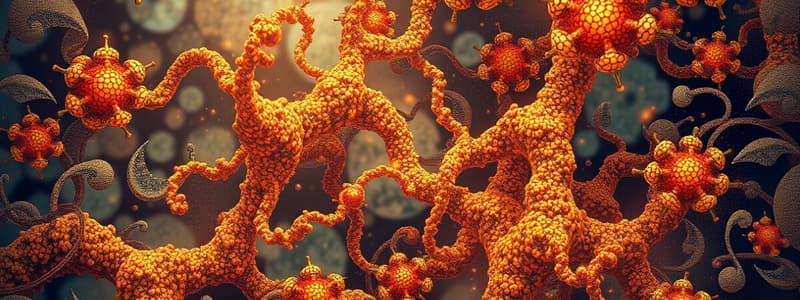Podcast
Questions and Answers
Enzyme kinetics studies the rates of enzyme-catalysed chemical reactions.
Enzyme kinetics studies the rates of enzyme-catalysed chemical reactions.
True (A)
Enzymes are typically carbohydrates that promote a reaction of another molecule.
Enzymes are typically carbohydrates that promote a reaction of another molecule.
False (B)
The enzyme-substrate complex is represented as ES.
The enzyme-substrate complex is represented as ES.
True (A)
The maximum rate an enzyme can achieve is unrelated to how easily it can be saturated with a substrate.
The maximum rate an enzyme can achieve is unrelated to how easily it can be saturated with a substrate.
In enzyme kinetics, the transition state is represented as ES*.
In enzyme kinetics, the transition state is represented as ES*.
Phosphoglucomutase is an example of a mutase.
Phosphoglucomutase is an example of a mutase.
Isomerases are commonly found in nature.
Isomerases are commonly found in nature.
DNA polymerase links a nucleotide to DNA by joining two substrates.
DNA polymerase links a nucleotide to DNA by joining two substrates.
Glyceraldehyde 3-phosphate dehydrogenase has two substrates and three products.
Glyceraldehyde 3-phosphate dehydrogenase has two substrates and three products.
Proteases release multiple products from a single substrate.
Proteases release multiple products from a single substrate.
Flashcards are hidden until you start studying
Study Notes
Enzyme Kinetics
- Enzyme kinetics explores the rates of enzyme-catalyzed chemical reactions and the effects of varying reaction conditions.
- Understanding enzyme kinetics reveals the catalytic mechanisms, metabolic roles, activity control, and interactions with drugs or modifiers like inhibitors or activators.
- Two main properties assessed include substrate saturation levels and the maximum reaction rate achievable by the enzyme.
- Enzymes (E) bind substrates (S) at the active site, forming an enzyme-substrate complex (ES), which transitions to an enzyme-product complex (EP) before yielding the final product (P) via a transition state (ES*).
- Simple reactions typically involve one substrate and one product but are less common than more complex two-substrate, two-product reactions, such as those catalyzed by NAD-dependent dehydrogenases like alcohol dehydrogenase.
- Enzymes may also catalyze reactions with several substrates or products; for instance, glyceraldehyde 3-phosphate dehydrogenase involves three substrates and two products.
- Enzyme kinetics can illustrate the order of substrate binding and product release, especially in enzymes like dihydrofolate reductase.
- Advanced measurement techniques involve monitoring fluorescence changes, providing insights into individual enzyme kinetics rather than averaged behavior of large populations.
Allosteric Enzymes
- "Allosteric" is derived from Greek, meaning "other space," indicating regulation where binding at one site influences another spatially distinct site.
- Allosteric enzymes are regulated by noncovalent binding to effectors or modulators, impacting their catalytic activities and controlling metabolic pathways.
- Metabolic pathways consist of interconnected reactions, where enzymatic reactions' abundance and activity influence the overall metabolic flux, or turnover rate of metabolites.
- Effector binding can be either heterotropic (where binding of a small ligand alters substrate binding at a different site) or homotropic (binding of substrate influences its own binding affinity on another subunit).
- Positive cooperativity occurs when effector binding enhances substrate binding affinity, while negative cooperativity occurs when it impedes subsequent enzyme activity.
- Allosteric enzyme kinetics follow a sigmoid growth curve rather than the hyperbolic form associated with standard Michaelis-Menten kinetics.
Notable Allosteric Enzymes
-
Phosphofructokinase (PFK):
- Key regulator in the glycolysis pathway, converting fructose-6-phosphate (F6P) to pyruvate.
- Contains two active sites for F6P and ATP, along with a regulatory site for ATP or AMP.
- ATP serves as a negative effector and AMP as a positive effector, modulating PFK activity based on cellular energy levels.
- AMP stimulates glycolysis during low energy, while excess ATP inhibits it, diminishing enzyme affinity to F6P.
-
Isocitrate Dehydrogenase (IDH):
- Central to the citric acid cycle (Krebs cycle), essential for aerobic metabolism and biosynthesis of biomolecules.
- Exists as heterodimers with catalytic and regulatory subunits, integrated into a normal operational framework.
- Citric acid binds to the allosteric site, inducing conformational changes that facilitate substrate isocitrate binding and enzyme activation.
- High levels of adenosine diphosphate (ADP) enhance cycle rates through additional binding alongside magnesium ions (Mg²⁺), stabilizing substrate interactions without directly altering conformation.
Studying That Suits You
Use AI to generate personalized quizzes and flashcards to suit your learning preferences.




